|
|
|
Sort Order |
|
|
|
Items / Page
|
|
|
|
|
|
|
| Srl | Item |
| 1 |
ID:
096266


|
|
|
|
|
| Publication |
2010.
|
| Summary/Abstract |
Manning difficulties and retention of skilled personnel is a timely issue in the British armed forces, and especially in the all-volunteer Royal Navy. Allied with difficulties of matching personnel numbers and posts, significant skill mismatches can take a long time to eradicate, with obvious financial and operational penalties. In the light of these factors, a holistic understanding of the exit behaviour of naval personnel is vital for naval manpower planners. This paper analyses ratings' voluntary (quits) and involuntary (separation) exit patterns from the Royal Navy using an independent competing risks hazard regression analysis framework. The results show that both voluntary and involuntary exits are pro cyclical with respect to macroeconomic and labour market conditions for both male and female ratings. Male ratings are more likely to quit or separate due to a lack of promotion to higher ranks as compared with females. Male ratings are also more likely to quit as a result of a hectic operational tempo when compared with their female counterparts. Frequency of sea/shore deployments also seems to exert a significant effect with respect to quits and separation outcomes of both genders. In terms of marital status married males are less likely to quit compared with their unmarried male counterparts, whereas the opposite is the case for female ratings.
|
|
|
|
|
|
|
|
|
|
|
|
|
|
|
|
| 2 |
ID:
091691
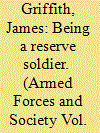

|
|
|
| 3 |
ID:
189955


|
|
|
| 4 |
ID:
101323


|
|
|
|
|
| Publication |
2010.
|
| Summary/Abstract |
The United States Army recently implemented a policy aimed at quelling a large-scale exodus of captains. This policy included the provision of a Menu of Incentives Program targeting officers in year groups 1999-2005. This study details the captain attrition problem, evaluates literature regarding retention options, analyzes the efficacy of the Army's interventions by branch and by year group, and draws conclusions regarding future incentives. Methods used include chi-square and odds ratios analysis. Results reflect high acceptance rates for year groups 1999-2003; however, officers in these year groups may have remained in the service without any additional incentives because they were logically beyond the initial decision point. Findings suggest that seniority, skill, and adequate incentive pay are important considerations for future incentive programs.
|
|
|
|
|
|
|
|
|
|
|
|
|
|
|
|
| 5 |
ID:
160652


|
|
|
|
|
| Summary/Abstract |
Researchers have, for decades, been attempting to estimate the effects of Selective Reenlistment Bonuses (SRBs) on the probability of reenlistment for the military services. SRBs are targeted to specific military occupations for which reenlistment rates are lower (or expected to be lower) than what is needed. This article first identifies four primary sources of biases affecting these models: reverse causality from supply shifts (a negative bias), the endogeneity of the decision point causing coded SRBs to be higher for reenlisters than leavers (a positive bias), measurement error (a likely negative bias), and excess supply preventing the full effect of an SRB change to materialize (a positive or negative bias). The report proceeds to develop a model that attempts to address the first two biases. With U.S. Navy data from FY2001-FY2008, I examine the extent to which these two biases are affecting the estimated SRB effects. Despite these corrections, the difficulty of addressing the other biases calls into doubt studies that examine the effects of retention bonuses or even the effects of the structure of military pay in general.
|
|
|
|
|
|
|
|
|
|
|
|
|
|
|
|
| 6 |
ID:
121747


|
|
|
|
|
| Publication |
2013.
|
| Summary/Abstract |
The Royal Navy (RN) is striving to achieve the right manpower mix through improved retention levels. This paper analyses the ratings' exit patterns from the RN using a hazard regression framework. We hypothesise that similar to civilian workers, job transition decisions of the RN ratings are dependent upon alternative job availability and macroeconomic conditions. In addition, working conditions, gender and skill mix, family commitments and promotion prospects in the Navy influence their decisions to leave early. We estimate the unemployment elasticity for males to be -0.65 (female -0.51), which is high, compared to the elasticity reported for the US Navy. The civilian wage is positively related to exit probability from the RN. Overall, married ratings are less likely to exit as compared to their unmarried counterparts, but married female ratings are 88% more likely to leave early as compared to unmarried females in the Navy. Promotion to higher ranks reduces the probability of early exists.
|
|
|
|
|
|
|
|
|
|
|
|
|
|
|
|
| 7 |
ID:
190788
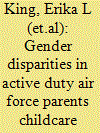

|
|
|
|
|
| Summary/Abstract |
Past reports indicate that enduring Department of Defense (DoD) childcare shortfalls may disproportionately affect women, but details regarding gender effects are unknown. This exploratory study sought to uncover the military childcare system’s pre-pandemic state by analyzing two Air Force (AF) survey datasets—the 2017 AF Community Feedback Tool and 2020 AF Childcare Survey—to examine gender gaps in active duty AF parents’ childcare access, cost and utilization, and perceptions of childcare impacts on career progression and retention. Results reveal that women—particularly those in the lowest ranks with less time on station—report more difficulties accessing childcare than male counterparts. Furthermore, fathers paid nothing for childcare and relied on spouses for childcare at higher rates, while mothers paid for care, relied on DoD childcare programs, were on DoD waitlists, reported childcare-related career impacts, and reported childcare affected their retention decisions at higher rates. Policy recommendations to improve childcare across the force are discussed.
|
|
|
|
|
|
|
|
|
|
|
|
|
|
|
|
| 8 |
ID:
091689


|
|
|
| 9 |
ID:
081059
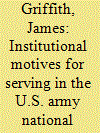

|
|
|
|
|
| Publication |
2008.
|
| Summary/Abstract |
The present study extended recent investigations of the motivations of American youth and active-duty soldiers to serve in the military. Unlike previous studies, this study employed a sample of reservists and examined their reasons for joining. Consistent with recent studies, institutionally-motivated soldiers were more likely to plan to remain in military service, would report for duty so they did not let their buddies and family down, and believed in the mission and service to the country. In contrast, materially-motivated soldiers were less likely to remain in reserve military service if deployed overseas, more likely to report for duty to meet contractual obligations and to avoid disciplinary actions, but less likely to report to serve the country. These factors have implications for the level of commitment and combat readiness of soldiers, in particular Army reservists, who are increasingly relied on for national defense strategy.
|
|
|
|
|
|
|
|
|
|
|
|
|
|
|
|
| 10 |
ID:
089495


|
|
|
|
|
| Publication |
2009.
|
| Summary/Abstract |
Retention is a crucial issue in the Armed Forces, especially in the all-volunteer Royal Navy. This is mainly due to a number of organisational challenges and changes in operational requirements and priorities. Naval manpower planners need to consider appropriate measures to improve retention in the service. The evidence gathered from the empirical investigation shows that external (pull) factors exert a significant effect on the early exit/quit rates from the RN. Key economic factors such as pay and employment opportunities in the civilian employment markets play an important role in the decisions that individual ratings make with regard to remaining in naval employment or leaving altogether. In particular, it was found that quit rates from the Navy are negatively associated with the claimant count (unemployment) rate (i.e. as the unemployment rate in the civilian economy increases, the early exit rate from the Navy decreases), whilst the overall increase in civilian wages bears a positive relationship on quitting behaviour. The analysis provides further evidence to support the need for policies that are tailor-made to cater for different ratings' specialisations within the Royal Navy.
|
|
|
|
|
|
|
|
|
|
|
|
|
|
|
|
| 11 |
ID:
094138


|
|
|
|
|
| Publication |
2010.
|
| Summary/Abstract |
U.K. Reserve Forces, principally the Territorial Army (TA), have been increasingly used since the end of the cold war, but there have been some concerns about their mental health problems and also possible unwillingness to remain in service. This article reports on the retention issues of 191 TA personnel who deployed to Iraq from 2003 to 2006. Qualitative data were thematically analyzed from three complementary studies. The authors found that, in 2003, negative aspects of Army organizational culture were reported as the prime reasons for TA personnel wishing to leave the military. In particular, Reservists reported their being unaccepted and underutilized. In contrast, by 2006, TA personnel were generally reporting being satisfied with their work as a Reservist and felt integrated with Regular colleagues. Those who stated they wanted to leave the military now reported it was primarily because of poor military family welfare support. These results suggest that although the British Army appears to have successfully managed the changing role and integration of the TA on operations, family welfare needs further consideration as an important influence on retention. Since the end of data collection for this study, new measures focusing on welfare have been introduced. Future work will assess the impact of these changes.
|
|
|
|
|
|
|
|
|
|
|
|
|
|
|
|
| 12 |
ID:
155200
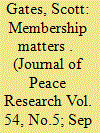

|
|
|
|
|
| Summary/Abstract |
Unable to attract enough voluntary recruits, many rebel groups rely on force to fill their ranks. Given that the group used force to compel individuals to join, a coerced conscript would be presumed unlikely to be loyal and would be expected to desert at the first opportunity. Yet, groups that have relied on coerced recruitment retain their members just as well as, if not better than, rebel armies that rely on voluntary methods of recruitment. This is a puzzle. How do rebel groups maintain allegiance and prevent desertion, especially if they rely on abduction to staff their ranks? A recruit can be forced to join a rebel group, but continuing to rely on coercion to enforce retention is too costly and not sustainable. These groups must find a way to reduce the costs of retention. The solution to this puzzle rests in the mechanisms of socialization that shape the allegiance of forcibly recruited soldiers. Socialization mechanisms are traced through three outcomes: compliance (or Type 0 socialization), role learning (Type I socialization), and norm internalization (Type II socialization). Integrating socialization theory and a rational choice analysis demonstrates that mechanisms that alter preferences through Type II socialization are effective in retaining recruits; the highest level of retention occurs when several mechanisms work in concert. Illustrative case studies of the Lord’s Resistance Army from Uganda, the Revolutionary United Front in Sierra Leone, the Maoists in Nepal, and the Liberians United for Reconciliation and Democracy (LURD) show that a reliance on child soldiers, group assets (pecuniary and non-pecuniary), organizational structure, and the nature of military contestation shape when different mechanisms are effective or not.
|
|
|
|
|
|
|
|
|
|
|
|
|
|
|
|
| 13 |
ID:
155822
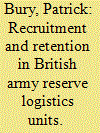

|
|
|
|
|
| Summary/Abstract |
The British Army Reserve (AR), and in particular its logistics component, is undergoing profound changes. The Future Reserves 2020 policy aims to expand the AR and make it more deployable on operations. However, to date, FR20 has struggled to attract the recruits required to man this more deployable reserve force, despite recruitment campaigns offering increased monetary benefits. This study sampled AR logistics soldiers’ reasons for joining, remaining in service, and mobilizing when deployed. Consistent with the previous research, the study found that soldiers who joined for institutional reasons were more associated with longer career intentions and mobilizing for intrinsic reasons. Soldiers who joined for occupational reasons were less satisfied with all elements of reserve service and deployed in order to fulfill their contracts. These trends suggest that recruitment campaigns that stress the pecuniary benefits of reserve service may attract soldiers less committed to reserve service and deployments and who are harder to retain.
|
|
|
|
|
|
|
|
|
|
|
|
|
|
|
|
| 14 |
ID:
141171


|
|
|
|
|
| Summary/Abstract |
This study examined whether satisfaction with the Air Force (AF) as way of life increased post-9/11 and whether it has sustained. Using data from 179,309 personnel collected across a period of eight years (2000–2008) in four waves of cross-sectional data collection, we found that satisfaction with the AF as a way of life increased dramatically following 9/11 and since then has declined from the height, but has not returned to pre-9/11 levels. After controlling for time as well as demographics, the best predictors of satisfaction were (1) feeling that the AF is a good environment for bringing up children, (2) a strong a sense of community, and (3) perceived strong unit leader support for members and their families.
|
|
|
|
|
|
|
|
|
|
|
|
|
|
|
|
| 15 |
ID:
085362


|
|
|
|
|
| Publication |
2009.
|
| Summary/Abstract |
This article examines the extent to which the professional orientation of Australian military personnel has shifted since September 2001. Four dimensions of professional orientation are identified, through analysis of ratings of reasons for serving in surveys conducted across the period 1996 through 2006. Duty/Professionalism represented Moskos's institutional orientation and Pay/Conditions, Development/Enhancement, and Adventure/Variety represented occupational orientation. The professional orientation of Other Ranks is now more pragmatic and more professional, in the sense that Pay/ Conditions and Duty/Professionalism motives are now more important as reasons for serving. Officers, on the other hand, have become less pragmatic and more professional, with Duty/Professionalism motives now dominant in professional orientation and Pay/ Conditions motives now much less important. Development/Enhancement and Adventure/ Variety are now less important for all categories. The article argues that these shifts are due to recent changes to Australia's strategic, social, and economic circumstances and notes the practical and scholarly implications of the results.
|
|
|
|
|
|
|
|
|
|
|
|
|
|
|
|
| 16 |
ID:
082694


|
|
|
|
|
| Publication |
2008.
|
| Summary/Abstract |
The U.S. federal government is increasingly civilianizing the military as a manpower-management strategy. Effects of this policy are not well understood. Data from a case study of civilian mariners integrated with sailors on a U.S. Navy ship were analyzed to determine the effects of social comparisons on each group's job satisfaction, organizational commitment, and intentions to remain with their current employer. Results indicate both sailors and civilian mariners view sailors as less advantaged compared to their civilian peers. The effect of these social comparisons on each group's satisfaction, commitment, and retention attitudes was mixed, having a significant negative impact for sailors but not for civilian mariners. These results identify an unintended negative consequence of the decision to integrate civilian and military personnel in an operational unit. The way civilian mariners were integrated is discussed as a possible reason for the differential effect of social comparisons between the two groups.
|
|
|
|
|
|
|
|
|
|
|
|
|
|
|
|
| 17 |
ID:
187102
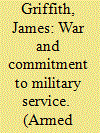

|
|
|
|
|
| Summary/Abstract |
The present study examined career intentions in two samples—home-based or garrison (N = 12,583 soldiers in 180 companies) and deployed and recently returned soldiers (N = 4,551 in 50 companies). Proportionally, fewer deployed soldiers than home-based garrison soldiers intended to stay in reserve military service. Among deployed soldiers, those who reported having experienced combat trauma, having had wounded or killed someone, and having had a friend killed in combat were less likely to plan to continue military service; reservists more likely to continue military service had returned to the same civilian job after deployment. Among deployed and garrison soldiers, fewer financial difficulties were associated with higher likelihood of continuing reserve military service. Examples from the social constructionist perspective of reserve military service are used to elaborate on mechanisms in these associations.
|
|
|
|
|
|
|
|
|
|
|
|
|
|
|
|
| 18 |
ID:
158445


|
|
|
|
|
| Summary/Abstract |
This paper investigates what motivates young people to volunteer for peace-keeping or peace-enforcing missions and how their motives change between pre- and post-deployment. Data include information about social and military background, and motives for more than 600 soldiers, 444 of whom answered the survey both before and after deployment. Soldiers are deployed to different missions under the same circumstances. To conceptualize motives among soldiers, we use factor analysis and find three factors: challenge, self-benefit, and fidelity. Challenge represents an occupational orientation; fidelity, an institutional orientation; and self-benefit, a desire for adventure. Exploiting the within-subject design of our data, we find that pre- and post-deployment motives vary significantly according to the type of mission and soldiers’ previous experiences (first-timers or experienced soldiers). Our results suggest that after the mission, peace-keepers are generally more disappointed than peace-enforcers. Our results also show that self-benefit motives are important for younger soldiers with only a high school education, and that this group usually serves as peace-enforcers during their gap year.
|
|
|
|
|
|
|
|
|
|
|
|
|
|
|
|
|
|
|
|
|